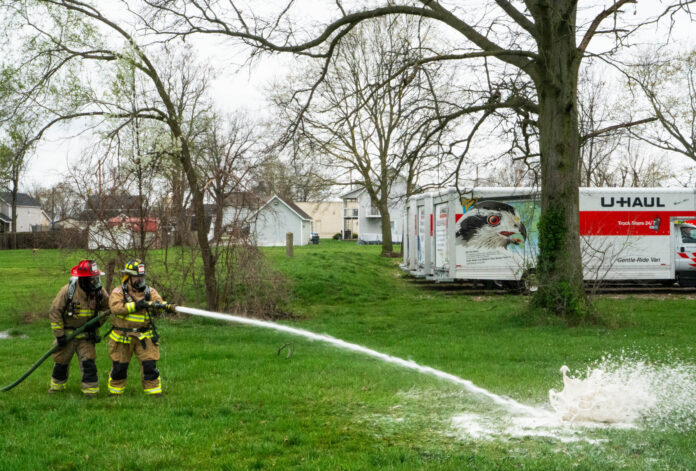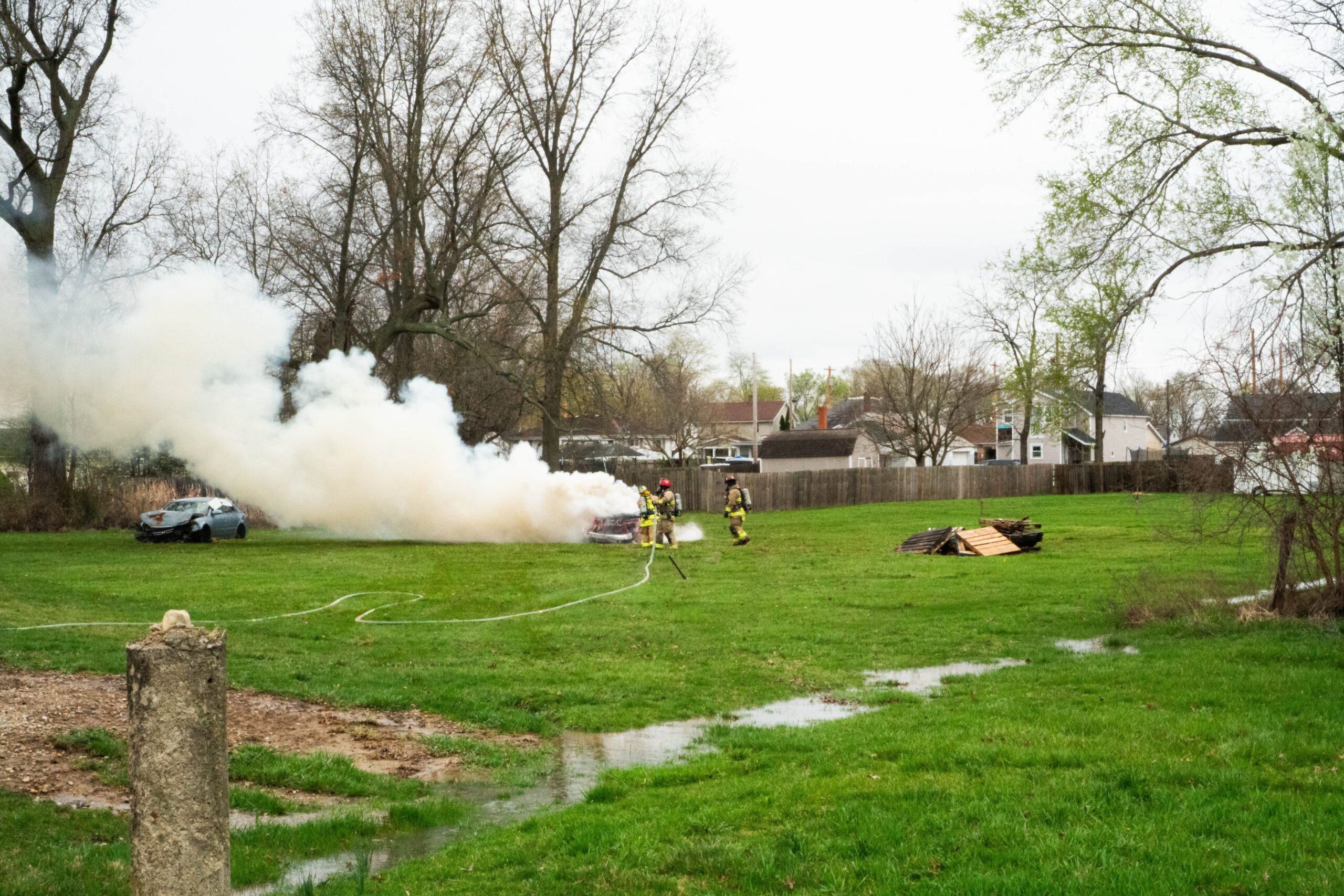
ASHVILLE, Ohio — A blazing fire erupts from an empty car in a field of grass, but this time, firefighters don’t rush to put it out; they wait until the flames get higher before demonstrating the power of a new PFAS-free, soy-based firefighting foam to a crowd of onlookers.
Harrison Township firefighters tested SoyFoam, developed by Cross Plain Solutions, for the first time at the Harrison Township Fire Department in Pickaway County, Ohio on March 31.
PFAS, also known as the forever chemical, has caused alarm across the country in the last few years after the cancer-causing chemical was found in water sources, air, soil, food and consumer and industrial products across the country. Fire-fighting foam is one of these products that contains PFAS.
But this new collaboration between firefighters and farmers aims to protect first responders and the environment while creating another market for soybeans in Ohio.
“We need to help fire departments have an idea of what they can replace those products with, and we know we’ve got this great soy-based product out there,” said Brandon Kern, deputy executive director of the Ohio Soybean Council and senior policy director for the Ohio Soybean Association. “That’s why we wanted to do this demonstration today.”
PFAS history
PFAS is a chemical compound created in the 1940s to repel water and oil. Because it has these properties, it is in numerous household products, including cleaning products, food packaging, nonstick cookware, cosmetics, personal care items like dental floss, water-repellent clothing, as well as stain-resistant carpets and upholstery.
The chemical has been used in firefighting foams — aqueous film-forming foams — and by the military since the 1970s.
According to a National Library of Medicine study, the world’s largest medical library operated by the United States federal government, PFAS is so prevalent in the U.S that nearly 98% of the U.S. population has detectable concentrations of PFAS in their blood.
The chemical can last thousands of years and is difficult to get rid of. It is also toxic to human health and, according to the U.S. Environmental Protection Agency, has been linked to reproductive problems, developmental effects in children, an increased risk of several types of cancer and a reduced ability for the body to fight infections.
This is the case for many firefighters, as cancer is the leading cause of line-of-duty death, reports the International Association of Fire Fighters. In 2023, 72% of IAFF line-of-duty deaths were caused by occupational cancer.
According to Virginia Technical Institute professor Brian Lattimer, PFAS is used in firefighting foams because it allows the foam to spread over the fire rapidly, effectively smothering it.
SoyFoam
Dave Garlie, chief technology officer at Cross Plains Solutions, a company based out of Dalton, Georgia, that develops new products and markets for corn and soybeans, started looking into alternative firefighting foams in 2015 after he was approached by a firefighter asking for help.
“It really didn’t come to my attention until a fireman came to me and says, ‘Can you fix the chemistry in these buckets? It’s killing us,’” he said. One study published in the medical journal Environmental Health Perspectives in 2023 found a significant link between PFAS and testicular cancer in military firefighters.
Garlie knew he needed to create something that was equally effective as the PFAS foam, but better for the environment. The first challenge in creating SoyFoam was figuring out how to use natural products that won’t degrade over time.
“How do you go about making Mother Nature behave herself, not break down and go rancid within a certain period of time,” Garlie said. “Once we cracked that code, which was the biggest challenge, then we’re off to the races.”
In October 2022, the United Soybean Board started investing in developing the new product as a training foam for firefighters.
According to Garlie, the United Soybean Board helped fund the product. To do this, the organization takes a percentage of the soy products that go to market, called farmer checkoff dollars, which then go toward research products in local communities, like SoyFoam.
Shortly after, the first version of SoyFoam, made primarily out of soy flour, was created. To test the effectiveness of the product, the company dispensed the foam to firefighting communities in Corydon, Kentucky, for feedback.
The product, however, was quickly dismissed as a training foam because the soy proteins are so effective in putting out fires, firefighters couldn’t relight objects used in training. Instead, SoyFoam went straight to the marketplace in April 2024.
Today, SoyFoam is “certified ready biodegradable by the Organization of Economic Cooperation and Development certified as 84% biobased through the U.S. Department of Agriculture BioPreferred program,” reports Cross Plain Solutions.
Supporting farmers
The soy flour used in SoyFoam is derived from soy meal, a byproduct of soy oil that is extracted from soybeans after they go to market.
“We’re producing an abundance of meal, more so than we can consume as humans and feed to livestock and we don’t want to landfill it,” Garlie said. “We’re trying to create a market that doesn’t exist today to create demand for that product.”
Others agree, including Kern who sees SoyFoam as a way to capitalize on this abundance of soy meal.
According to the Ohio Soybean Council, 79.2% of a bushel of soybeans consists of soy meal, with oil making up 17.8%. Kern says Ohio has put a lot of effort into researching and creating markets for soy oil, but not nearly as much into soy meal.
He adds that making more products using soy meal, like SoyFoam, will increase the value of soybeans.
“It’s a great win-win,” Kern said. “For soybean farmers, we’re building demand, but it’s also solving a significant problem. We don’t want firefighters using a product where they have to fill out an exposure report every time they use the product, right?”
Heathier firefighters
Colt Cline, assistant chief of the Harrison Township Fire Department, joined the department in 2006 when fire stations were starting to get rid of the PFAS foam. He didn’t have much experience using the PFAS foam, but knew other departments were being impacted.
“A lot of neighboring departments would get guys with cancer, and they would trace it back to the foam,” Cline said. But getting rid of the PFAS foam wouldn’t solve the problem entirely. Without a replacement, firefighters had to carry and use more water to extinguish fires, Cline said.
In 2015, Cline’s fire department started using a PFAS-free Class A firefighting foam — Class A refers to foams that fight wood and paper fires, and Class B is for flammable liquid fires. However, a decade later, a better alternative would hit the market: SoyFoam.
In February, Cline got a call from Kern asking if the Harrison Township Fire Department would be the first fire department in Ohio to do a demonstration with Cross Plain Solutions’ SoyFoam, a Class A and B firefighting foam. Without hesitation, he said yes.
“What’s exciting is being one of the first, or if not the first, department in Ohio to use this product,” Cline said, at the event on March 31. “I think that’s a big thing. People look at us and think we’re just a small, rural department, but we’re actually doing big things, trying to be a front-runner in Ohio.”

The demonstration was the department’s first time using SoyFoam. Although the product is relatively new in Ohio, other states are already using it, including Wisconsin, North Dakota, Minnesota, Kentucky, Virginia and more. According to Garlie, 215 departments in North Dakota have received SoyFoam, and eight have fully transitioned into using the product.
Ohio has also been working to destroy old PFAS — known as the forever chemical — firefighting foams through Ohio Gov. Mike DeWine’s Ohio Statewide Firefighting Foam Takeback Program, launched in March 2024.
The program uses PFAS Annihilator technology, developed by Battelle, to destroy PFAS firefighting foams to non-detectable levels through the process of supercritical water oxidation.
“The development of this technology is just another example of how Ohio continues to lead the nation in innovation,” DeWine said in a press conference, celebrating the launch of the program. “Through this new program, we’re destroying PFAS, which was once believed to be indestructible, to protect our first responders and safeguard the environment.”
(Liz Partsch can be reached at epartsch@farmanddairy.com or 330-337-3419.)









